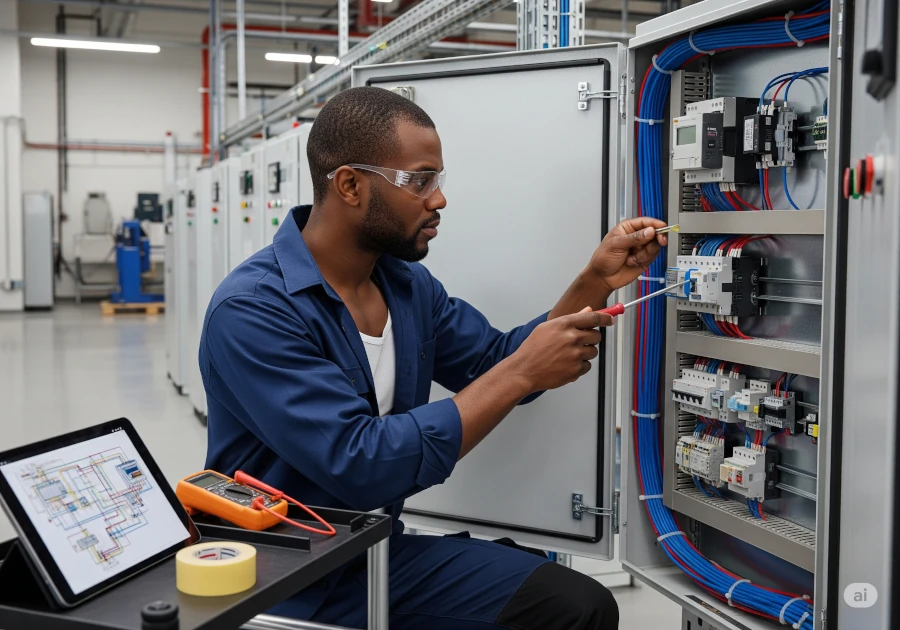
Electrical Controls & PLC Technician
Ray Gillette
Course Overview
This course introduces apprentices to the world of automation, control systems, and Programmable Logic Controllers (PLCs). With manufacturing and utilities in Guyana becoming increasingly automated, this program is ideal for those seeking to enter industrial automation, facility maintenance, or advanced electrical diagnostics.
Key Topics:
- Introduction to Control Systems & Ladder Logic
- Wiring of Control Panels and Enclosures
- PLC Programming (Basic & Intermediate Logic)
- Sensors, Relays, Timers, and Contactors
- Input/Output Devices and HMI Interfaces
- Troubleshooting PLC Circuits and Error Codes
Skills Gained:
- Read and create ladder diagrams
- Wire and test industrial control panels
- Write and simulate basic PLC programs
- Diagnose faults in automated systems
Career Pathways:
- Industrial Electrician
- Automation Technician
- PLC Control Systems Integrator
Detailed Training Outline – PLC Technician Certification
1. Introduction to Industrial Automation and PLCs
- Overview of industrial control systems and automation
- Role of a PLC in modern automation
- Advantages of PLCs over traditional relay logic systems
- Typical applications in manufacturing, process control, and utilities
2. Understanding PLC Hardware
- PLC system architecture
- Power supply units and voltage requirements
- Central Processing Unit (CPU) functions and memory types
- Input/Output (I/O) modules: digital vs analog
- Communication modules and interface ports
- Rack-based vs modular vs compact PLCs
3. Field Devices and Control Elements
- Types of input devices: pushbuttons, switches, sensors (proximity, photoelectric, inductive)
- Types of output devices: solenoids, contactors, indicator lights, motors, valves
- Signal types: sourcing vs sinking, discrete vs analog
- Wiring principles: terminal blocks, shielding, grounding
- Understanding and drawing I/O wiring diagrams
4. Electrical Standards and Safety
- Lockout/tagout (LOTO) procedures
- Personal Protective Equipment (PPE) for control systems work
- Electrical code considerations (IEC, NEC)
- Safety interlocks, emergency stops, and fail-safe design
- Introduction to Safety PLCs and risk reduction
5. Introduction to PLC Programming
- Basic logic concepts: Boolean logic, truth tables
- Programming methods:
- Ladder Logic (primary focus)
- Function Block Diagram
- Instruction List (deprecated but reviewed)
- Structured Text (introductory overview)
- Addressing schemes for I/O and memory
- Tag-based addressing (used in modern platforms like Allen-Bradley)
6. Core Programming Instructions
- Bit logic operations: XIC (Examine If Closed), XIO (Examine If Open), OTE (Output Energize)
- Timers: TON (on-delay), TOF (off-delay), RTO (retentive)
- Counters: CTU (count up), CTD (count down), reset logic
- Comparison functions: greater than, less than, equal
- Arithmetic instructions: add, subtract, multiply, divide
- Move and data handling instructions
7. PLC Programming Software and Simulation Tools
- Introduction to vendor-specific software platforms:
- Allen-Bradley Studio 5000 or RSLogix 500
- Siemens TIA Portal
- Mitsubishi GX Works
- Creating and downloading programs
- Online editing, monitoring, and forcing values
- Use of simulation environments for testing logic
8. Analog I/O and Advanced Functions
- Analog signal types: 4-20mA, 0-10V
- Scaling raw analog values
- Use of analog inputs for sensors and process control
- Analog outputs for actuators and speed control
- Data logging, trending, and PID control basics
9. Human-Machine Interface (HMI) Integration
- Role of HMI in PLC systems
- Creating simple HMI screens for monitoring and control
- Tag linking between HMI and PLC
- Alarms, trends, and user input fields
- Intro to touch screen terminals (e.g., PanelView, Siemens KTP)
10. Industrial Networks and Communication
- Common industrial protocols:
- Ethernet/IP
- Modbus (RTU and TCP)
- Profibus/Profinet
- DeviceNet
- IP addressing and subnetting basics
- Network topologies in automation
- Integrating PLCs with SCADA and MES systems
11. Troubleshooting and Diagnostics
- Systematic troubleshooting approach
- Reading and interpreting ladder diagrams
- Using cross-reference and search tools
- Diagnosing hardware vs software faults
- Using PLC status indicators, fault logs, and diagnostic bits
- Common wiring and grounding problems
12. Hands-On Practical Labs
- Real-world PLC programming tasks
- Building, wiring, and commissioning small control systems
- Simulating faults and practicing diagnostics
- Creating HMI interactions with PLC logic
- Working with sensors, relays, and actuators
13. Capstone Project
- Design and implement a control system (e.g., motor starter, conveyor system, tank filling automation)
- Document I/O list, ladder logic, wiring diagram, and operational sequence
- Present and demonstrate project functionality
14. Final Assessment and Certification
- Written exam covering theory and programming
- Practical hands-on evaluation
- Feedback session and certificate issuance
- Completion of Electrician Level III
